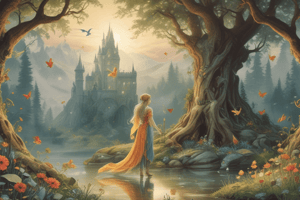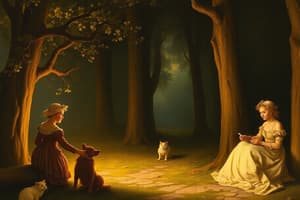Podcast
Questions and Answers
Who created the word 'fairy tale' in the late 17th century?
Who created the word 'fairy tale' in the late 17th century?
The French writer Madame d'Aulnoy
Who first defined the term 'folklore' in 1846?
Who first defined the term 'folklore' in 1846?
The English antiquarian William Thoms
True or False: Fairy tales are typically written in complex, poetic styles with significant realism.
True or False: Fairy tales are typically written in complex, poetic styles with significant realism.
False (B)
What is considered the earliest prose literature of Britain, collected around 1350-1410?
What is considered the earliest prose literature of Britain, collected around 1350-1410?
Which French author created the collection 'Tales of Mother Goose' in 1697?
Which French author created the collection 'Tales of Mother Goose' in 1697?
Who published the 'Norwegian Folktales' in 1841?
Who published the 'Norwegian Folktales' in 1841?
What epic poem celebrating Finnish folklore was compiled by Elias Lonnrot between 1835-49?
What epic poem celebrating Finnish folklore was compiled by Elias Lonnrot between 1835-49?
What was a primary motivation for the Brothers Grimm in collecting fairy tales?
What was a primary motivation for the Brothers Grimm in collecting fairy tales?
True or False: The Brothers Grimm primarily gathered their stories by traveling into remote forests and listening to peasants.
True or False: The Brothers Grimm primarily gathered their stories by traveling into remote forests and listening to peasants.
True or False: The first edition of the Grimms' Fairy Tales was written mainly for a child audience.
True or False: The first edition of the Grimms' Fairy Tales was written mainly for a child audience.
How does the Grimms' version of Cinderella differ from Charles Perrault's regarding the fate of the stepsisters?
How does the Grimms' version of Cinderella differ from Charles Perrault's regarding the fate of the stepsisters?
In the Grimms' version of Cinderella, what object serves as the magical helper?
In the Grimms' version of Cinderella, what object serves as the magical helper?
What role did characters later depicted as 'wicked stepmothers' often play in the earliest versions of the Grimms' tales?
What role did characters later depicted as 'wicked stepmothers' often play in the earliest versions of the Grimms' tales?
What is the typical function of the 'witch or sorceress' archetype in folklore?
What is the typical function of the 'witch or sorceress' archetype in folklore?
Besides collecting folk tales, what other academic fields were the Brothers Grimm known for?
Besides collecting folk tales, what other academic fields were the Brothers Grimm known for?
What new literary genre, focusing on social structures and manners, emerged in England by the close of the 18th century?
What new literary genre, focusing on social structures and manners, emerged in England by the close of the 18th century?
Which author's novels, such as Pride and Prejudice, are prime examples of the English novel of manners?
Which author's novels, such as Pride and Prejudice, are prime examples of the English novel of manners?
Which 1740 novel by Samuel Richardson, about a servant girl rising in social rank, is considered an early novel of manners?
Which 1740 novel by Samuel Richardson, about a servant girl rising in social rank, is considered an early novel of manners?
Which 1847 novel by Charlotte Bronte critiques Victorian class divisions and the restrictions placed upon women?
Which 1847 novel by Charlotte Bronte critiques Victorian class divisions and the restrictions placed upon women?
Who is the principal character and narrator perspective in Pride and Prejudice?
Who is the principal character and narrator perspective in Pride and Prejudice?
What is Elizabeth Bennet's initial judgment of Mr. Darcy based on?
What is Elizabeth Bennet's initial judgment of Mr. Darcy based on?
Who unexpectedly helps the Bennet family resolve the scandal caused by Lydia's elopement with George Wickham?
Who unexpectedly helps the Bennet family resolve the scandal caused by Lydia's elopement with George Wickham?
What does Jane Austen suggest about the relationship between 'good breeding' (high social rank) and 'good manners' in Pride and Prejudice?
What does Jane Austen suggest about the relationship between 'good breeding' (high social rank) and 'good manners' in Pride and Prejudice?
What was the original title of Jane Austen's novel Pride and Prejudice?
What was the original title of Jane Austen's novel Pride and Prejudice?
True or False: Jane Austen, who wrote extensively about marriage, married shortly after publishing Pride and Prejudice.
True or False: Jane Austen, who wrote extensively about marriage, married shortly after publishing Pride and Prejudice.
Flashcards
Fairy Tale
Fairy Tale
A story with random magic, reward, revenge, random characters, and a happy ending, written in plain and simple styles.
Mabinogion
Mabinogion
Oral tales based on Welsh stories, representing the earliest prose literature of Britain.
Charles Perrault
Charles Perrault
He is known for rewriting fairy tales such as 'Tales of Mother Goose'.
Tales of Mother Goose
Tales of Mother Goose
Signup and view all the flashcards
Grimm Brothers
Grimm Brothers
Signup and view all the flashcards
Archetypal Characters in Folklore
Archetypal Characters in Folklore
Signup and view all the flashcards
Jacob and Wilhelm Grimm
Jacob and Wilhelm Grimm
Signup and view all the flashcards
Grimm Brothers' Monumental Work
Grimm Brothers' Monumental Work
Signup and view all the flashcards
Novel of Manners
Novel of Manners
Signup and view all the flashcards
Jane Austen
Jane Austen
Signup and view all the flashcards
Pamela by Samuel Richardson
Pamela by Samuel Richardson
Signup and view all the flashcards
Jane Eyre
Jane Eyre
Signup and view all the flashcards
The House of Mirth
The House of Mirth
Signup and view all the flashcards
Pride and Prejudice
Pride and Prejudice
Signup and view all the flashcards
Fitzwilliam Darcy
Fitzwilliam Darcy
Signup and view all the flashcards
Elizabeth Bennet
Elizabeth Bennet
Signup and view all the flashcards
Study Notes
Grimm's Fairy Tales
- The term "fairy tale" originated with French writer Madame d'Aulnoy in the late 17th century.
- Charles Perrault's fairy tale retellings are more famous than d'Aulnoy's.
- William Thoms, an English antiquarian, created the term "folklore" in 1846 in a letter to The Athenaeum magazine.
- Welsh Mabinogion tales from the 14th century had a spiritual or religious purpose.
- Traditional fairy tales lack real people, places, or events, starting with "once upon a time..."
- In Fairy tales the reader anticipates magic, reward, revenge, random characters, and happy endings.
- Fairy tales are written in plain language with direct imagery, avoiding poetic references and realism.
Timeline of Folklore
- c. 1350-1410: Oral Welsh tales are compiled in the Mobinogion, Britain's earliest prose literature.
- 1697: Charles Perrault, a French author, wrote Tales of Mother Goose, a collection of rewritten and original stories.
- 1782-87: Johann Karl August Musaus, a German author, published a collection of satirical folk series.
- 1835-49: Elias Lonnrot's epic poem Kalevala celebrates Finnish folklore.
- 1841: Peter Christen Asbjornsen and Jorgen Moe released Norwegian Folktales.
- 1979: Angela Carter's novel The Bloody Chamber challenges traditional folktale portrayals of women.
- "Grimm's Fairytale" focuses on folklore collections blending oral history, fairy tales, and popular briefs from the Middle Ages.
- The Brothers Grimm aimed to preserve the spirit of the people by documenting fairy tales.
- Interest in folklore rose due to nationalism and cultural pride, inspiring the Grimms' collection.
- The Grimms' Children's and Household Tales is a significant and widely translated body of European stories.
- W.H. Auden considered Grimms' tales foundational to Western culture.
- The Brothers Grimm collected their stories directly from people, including written submissions like "The Juniper Tree" from painter Philip Otto Runge.
- The Grimms' first edition was for adults; revisions to sanitize the stories for children came after Edgar Taylor's 1823 English translation.
- Early versions of stories like "Rapunzel" were altered to remove mature themes like pregnancy.
- In the Grimms' version of Cinderella, Cinderella's helper-birds peck out her stepsisters' eyes, unlike Perrault's version where Cinderella forgives her stepsisters.
- The Grimms' tales have maintained popularity, interpretations, and adaptations across various media due to their romantic depiction of inextinguishable truths.
Archetypal Folklore Characters
- The Magical Helper: In the Grimms' Cinderella, a hazel tree at the mother's grave provides Cinderella's outfit instead of a fairy godmother.
- The Wicked Stepmother: Early Grimm versions featured mothers as villains; later versions changed them to stepmothers to preserve motherhood's sanctity.
- The Witch or Sorceress: This archetype leads to shifts in plot and sparks magical events that are often terrible.
- The Trickster: This archetype creates challenges to the natural order.
- The Transformed Animal: Characters transform into animals and may regain human form.
Jacob and Wilhelm Grimm
- Jacob (1785–1863) and Wilhelm (1786–1859), known as the Brothers Grimm, were German academics, linguists, and cultural researchers.
- They were raised in Hanau, Hesse, and educated at the University of Marburg due to their aunt's support.
- The Grimms developed a folk story collecting methodology that is the basis for folklore studies.
- The Grimms were philologists and worked on a 32-volume German dictionary that remained unfinished.
Pride and Prejudice
- The novel of manners emerged in England, moving away from Romanticism's excesses by focusing on beliefs, manners, and social structures.
- These novels were often centered on women, both as authors and main characters, leading to their frequent trivialization.
- Jane Austen's novels exemplify this genre, satirizing English country gentry and Gothic Romanticism.
- Austen’s focuses on the vulgarities of the English upper class, the importance of the rank, the stigma of the social inferiority, and the system of the patronage
Timeline of Novels
- 1740: Samuel Richardson's Pamela is the story of a servant rising in social status and is considered an early novel of manners.
- 1847: Charlotte Bronte's Jane Eyre critiques class divisions, prejudice, and societal expectations for women.
- 1847-48: William Makepeace Thackeray's Vanity Fair satirizes duplicity and dishonesty via Becky Sharp.
- 1905: Edith Wharton's The House of Mirth depicts social, economic, and moral constraints on women in America.
- Pride and Prejudice follows the Bennet sisters seeking eligible bachelors, marriage being crucial for women's social status.
- Elizabeth Bennet is the main character and one of five daughters to Mr. Bennet, a country gentleman, and his vulgar wife.
- Elizabeth dislikes Fitzwilliam Darcy due to his arrogance, contrasting with Bingley, who likes Elizabeth's sister Jane.
- Lydia elopes with George Wickham, is saved by Darcy, Elizabeth Bennet learns from her errors and matures.
- Darcy overcomes his pride, becoming worthy of Elizabeth.
- Austen uses wit and irony to show that good breeding doesn't always mean good manners, exploring society's manners and morals.
Jane Austen
- Jane Austen (1775-1817) was the daughter of a country person born in Stevenson rectory, Hampshire, England, the seventh of eight children.
- She read extensively from her father's library and began writing early, producing an early version of Pride and Prejudice called First Impressions (1796-1797). -In 1800, her father retired and the family moved to Bath, where Austen was unhappy. In 1809, she moved to Chawton, Hampshire, writing daily and observing genteel life.
- She wrote about marriage but never married, although she received a proposal.
Studying That Suits You
Use AI to generate personalized quizzes and flashcards to suit your learning preferences.




